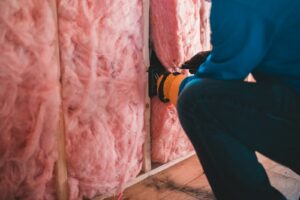Here’s how we stop the built world from being a contributor to GHG emissions
The UK’s undershoot on heat pumps underlines the challenge of decarbonising the built world. Catriona Hyland, research analyst at A/O, presents six priorities we need to tackle urgently.
Once again, despite good intentions, targets and soundbites, yet another attempt at decarbonising our homes is on the ropes as it’s reported the uptake of heat pumps across the UK has sputtered and stalled.
If we’re to meet our climate change targets, the government wants to install 600,000 low-carbon heat pumps a year over the next four years. In 2022, total installations hit just 55,000. The blame has been placed on their price, low awareness among consumers and divisions within government itself. Wherever blame lies, we’re falling damagingly short of making this necessary change.
Decarbonising homes is a priority for the government because heating generates 18% of UK’s total greenhouse gas emissions. These emissions contribute to the wider, large-scale emissions created by the built world as a whole. Data shows that of the 50 billion tonnes of greenhouse gases released each year, and counting, more than a third (37%) comes from the built world. Three quarters of buildings in the EU are classed as energy inefficient – a number that’s set to rise to as much as 90% by 2050 – and the world’s carbon dioxide emissions from energy rose yet again in 2023. All against a backdrop of another month of record-breaking global air, and sea surface temperatures in February.
Decarbonising the built world sector, therefore, is urgently required if we are to meet our global climate targets. Yet the scale of the problem, and in particular knowing what to prioritise, also presents the greatest challenge.
Building owners and investors are increasingly waking up to this challenge, as are policy makers. But as the National Audit Office’s report on decarbonising home heating demonstrates, change can not be driven in isolation. There must be a considered and joined up approach where we double down on the most impactful factors. Here are the most pressing.
1. Powering up the grid: There are systemic difficulties in making the switch to renewable energy. One of the biggest being how we power up the grid to be able to reliably and sustainably access the renewable energy we generate. If we’re to make the transition, we urgently need to create better energy storage, and smarter trading and grid tech solutions. Investors need to ramp up investments into companies building future-proofed grids, while real estate owners and property developers need to play their role, from fitting solar arrays and batteries, to investing in ways to monitor building efficiency and reducing the costs associated with clean energy.
2. Addressing the labour and skills shortage: The energy transition is creating huge demand for new skills in construction causing global, industry-wide transformations the likes of which haven’t been since the Industrial Revolution. This shift will require the workforce involved in the retrofitting and climate tech sector to quadruple by 2030. At the same time, there is an urgent need for plumbers, welders, joiners, fitters, electrical engineers and surveyors to upskill. Companies like Germany’s Enter are helping to address this talent shortage, but the private sector cannot meet this demand alone. There needs to be a public policy push towards training programmes, apprenticeships, and reskilling initiatives that make these skills a priority.
3. Building smarter with AI: There’s a huge, and relatively untapped, opportunity to solve many of the problems facing today’s inefficient and unsustainable built world sector using Generative AI and automation. These systems can optimise design, improve efficiency, and reduce errors in construction. Bricklaying robots in Europe, from firms like Monumental, work alongside humans to improve productivity and safety. Yet such advancements require deep collaboration between tech companies, construction firms and the investors backing these technologies to introduce tools that materially shift the dial.
4. Electrifying industry: Industrial heat generation releases massive carbon emissions which need to be tackled. One solution would be to mandate the electrification of industrial processes. Industrial heatpumps and electrical heating solutions will target industrial energy consumption at the lower temperature range, where there is substantial demand. For higher temperature applications that are today predominantly supported by natural gas, coal and biomass, there are emerging thermal storage solutions that can make use of green energy to charge and discharge high temperature heat from companies like Kraftblock.
5. Greener banks: Banks already play a critical and trusted role in financing the built environment and they can help drive the energy transition by acting as a key bridge between public and private capital. Whether that’s through their own partnerships with installers, connecting solution providers to utilities and real estate funds, or instilling trust among consumers. Governments also play a role, through regulations, policies and incentives, that can encourage banks to ‘green’ their loan portfolios. This will not only help boost investments in energy-efficient real estate and green technologies but will help the banks mitigate the energy risk of having property or loan portfolios.
6. Energy for all: Investing into the technologies and policies needed to decarbonise the built world can also have a substantial impact on society. Not just in terms of fuelling economic growth through employment and returns, but in levelling the playing field. A staggering 41 million Europeans were unable to keep their homes warm in 2022. Making energy-efficient housing more accessible and affordable is therefore key, especially for low-income communities. Leaning on tech to retrofit buildings, promote smart meter usage and expanding access to renewable energy will also significant societal gains. Gains that require governments, solution providers, and property developers to be on the same page.
Heat pumps are only the tip of a very large iceberg when it comes to decarbonising our built world. Technology will be essential to address the problems caused by the built world. But long-term changes – that cut across political parties – are needed to accelerate change and to maximise the value of public and private investment in this area.
Images: Youssef Abdelwahab and Ümit Yıldırım
More features:
What should be the approach to UK placemaking? Patience could be prosperous

















